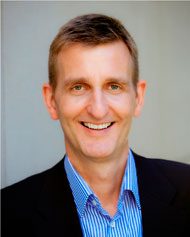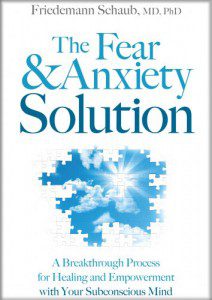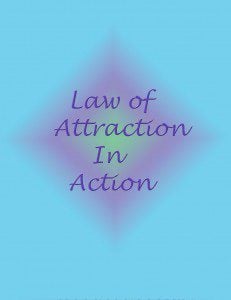 I’m delighted top have Friedemann Schaub MD., Ph.D., the founder of Cellular Wisdom, back as my guest today. He works with people to help them improve their health using both inner tools and his medical background. I’m also thrilled to be part of the launch for his new book, The Fear and Anxiety Solution. His new book is full of suggestions for taking control of any fear or anxiety you might have. And right now he’s offering a huge array of free gifts (including one from me) if you order The Fear and Anxiety Solution. Today he shares his knowledge about how much your subconscious is responsible for creating and holding onto things that create fear and anxiety. Here’s what he has to say.
I’m delighted top have Friedemann Schaub MD., Ph.D., the founder of Cellular Wisdom, back as my guest today. He works with people to help them improve their health using both inner tools and his medical background. I’m also thrilled to be part of the launch for his new book, The Fear and Anxiety Solution. His new book is full of suggestions for taking control of any fear or anxiety you might have. And right now he’s offering a huge array of free gifts (including one from me) if you order The Fear and Anxiety Solution. Today he shares his knowledge about how much your subconscious is responsible for creating and holding onto things that create fear and anxiety. Here’s what he has to say.
How Our Subconscious Scares Us
Friedemann Schaub MD., Ph.D.
You’re in a hurry, and of course your keys are hiding again. You look for them everywhere, becoming increasingly anxious. Finally you discover them right where you always put them. Hadn’t you checked there before at least twice?
Or maybe you’re on your way to an interview. You feel good until you notice that mustard stain on your shirt. All your confidence slips away, and you start to panic. You’re sure that you will make a terrible impression, because all the interviewer will notice about you is that stain—just as you do.
Why is it that you can’t see certain things you want to (your keys), whereas other things you want to ignore (mustard) are all you can focus on?
Every second of our lives, we’re surrounded by an incomprehensible amount of information. We need to filter out a large portion to make sense of the world and not become completely fried. But how do we distinguish the tiny fraction of information that is relevant from all the remaining input that needs to be ignored? If we tried to make these distinctions consciously, we wouldn’t be able to do anything else. Literally all our focus and energy would be devoted to deciphering and sorting every single detail in and around us. This is where our subconscious mind comes in and employs specific filters to separate what it perceives to be important for us.
In a study conducted at Columbia University in New York, volunteers were shown pictures of random people with neutral expressions. The researchers also displayed random images of people with fearful expressions. The images with the fearful faces appeared and disappeared so quickly that the volunteers weren’t consciously aware of them. However, functional magnetic resonance imaging (fMRI) scans—which measure changes in blood flow—clearly demonstrated that the brain had registered the fearful faces, even though the subjects denied seeing them.1 This study shows that our subconscious not only filters and processes information, it is also able to perceive external input much more quickly and in more subtle forms than the conscious mind can.
Subconscious filters consist of memories, emotions, inner conflicts, and beliefs. They delete, distort, and generalize information that passes through them and leave us with a condensed and altered version of all that surrounds us—an internal interpretation of reality. Since most people are not consciously aware of their subconscious filters, they’re also unaware that their view of the world is basically just “made up.” Which also means that whatever you think you are is just a fraction of the truth.
Why does your subconscious make you overlook the keys you are desperately searching for and magnify the mustard stain you don’t want to see? Well, in both cases the subconscious mind is on a mission to protect you. By activating the anxiety response, you’re being prepared for the negative consequences of being late, which could be embarrassment, criticism, or rejection. As your subconscious shifts your awareness from the present to a possibly unpleasant future, most of the available information of your surroundings (your keys) gets deleted. The same intention, to keep you safe, is also true for the mustard stain on your shirt. Your subconscious distorts and blows up the stain to get you ready for the judgment and rejection that might await you. Logically, you need to concentrate on what is right in front of you—finding the keys or focusing on the agenda of your meeting; however, subconsciously, you’re already bracing yourself for the worst.
Your response to situations like these depends on the fabric of your subconscious filters. Your fear and anxiety filters dictate how you interpret the danger or safety of your reality. The more prominent these subconscious anxiety filters are, the faster and stronger you react to potential peril such as misplacing your keys or staining your shirt. Your reaction creates more stress, which in turn increases your chance of overlooking your keys and spilling more food.
So it makes sense that to break through these emotions and their ensuing behavioral patterns, you need to consciously remove and replace these subconscious filters. Removing the filters doesn’t mean you will permanently turn off or even dismantle the anxiety switch. As I said before, fear and anxiety are normal and important parts of life. You don’t want to abolish your ability to create these feelings, because they provide you with valuable information and are powerful catalysts for continuous growth and self-empowerment. But what if you could convert the anxiety switch into a dimmer switch—one you learn how to operate with increasing proficiency?
*********************
Check out Friedemann Schaub‘s new book, The Fear and Anxiety Solution. He’s offering a huge array of free gifts (including one from me)–all sorts of material from other experts that you can benefit from. I recommend you order it and take advantage of all the freebies!
********************
Join The Self-Love Movement! Take the 31 Days of Self-Love Commitment –a pledge to start your year by doing something kind for yourself for the first 31 days of January–and get my book, How Do I Love Me? Let Me Count the Ways for free at http://howdoiloveme.com. And you can post your loving acts HERE to reinforce your intention to love yourself. Read my 2012 31 Days of Self-Love Posts HERE.
Please leave comments under my posts so we can stay connected.

